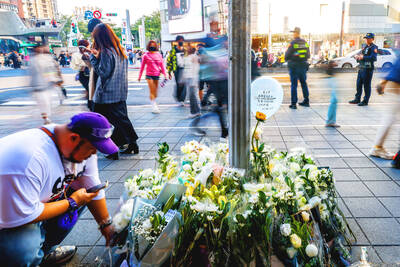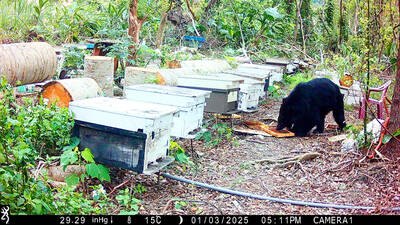Taipei Mayor Hau Lung-bin (郝龍斌) yesterday acknowledged the inappropriateness of painting the Chinese Nationalist Party (KMT) emblem on national monuments that are being repaired and promised to discuss the issue with the Council for Cultural Affairs (CCA).
The Taipei City’s Department of Cultural Affairs budgeted NT$7 million (US$215,000) to restore the city’s four historical gates earlier this year — the East Gate (also known as Jinfu Men), the South Gate, the Little South Gate and the North Gate.
Democratic Progressive Party (DPP) Taipei City councilors said that the department, taking advantage of the restoration work, painted the KMT emblem on the East Gate and planned to paint the party’s emblem on the three other gates.
DPP Taipei City Councilor Huang Hsiang-chun (黃向群) criticized the city government yesterday, saying that the move was part of a plan to restore dictatorship and party-state rule.
Hau, a member of the KMT, said the four gates were national monuments and that the city government was authorized by the CCA to maintain the gates.
“It is inappropriate to paint the KMT emblems on the four gates if the patterns were not there originally,” he said.
Department of Cultural Affairs Commissioner Lee Yong-ping (李永萍) said the KMT emblems were first painted in 1966 when the KMT modified gates left over from the Qing Dynasty.
The four gates were designated as national monuments in 1998. The Culture Heritage Preservation Act (文化資產保存法) stipulates that restoration work on national monuments can not modify the monuments, she said.
“We are simply restoring the four gates and making the monuments the way they were in 1966. The KMT emblems were on the gates, and so it is natural for us to repaint them,” said Lee, who is also a KMT member.
Lee said having KMT emblems on historical monuments could be controversial in modern times and that the department would follow the law and hold public hearings to seek a consensus before changing monuments.
The city government will gather opinions at public hearings and present them to the CCA, which will make a final decision on the issue, she said.

SHIPS, TRAINS AND AUTOMOBILES: The ministry has announced changes to varied transportation industries taking effect soon, with a number of effects for passengers Beginning next month, the post office is canceling signature upon delivery and written inquiry services for international registered small packets in accordance with the new policy of the Universal Postal Union, the Ministry of Transportation and Communications said yesterday. The new policy does not apply to packets that are to be delivered to China, the ministry said. Senders of international registered small packets would receive a NT$10 rebate on postage if the packets are sent from Jan. 1 to March 31, it added. The ministry said that three other policies are also scheduled to take effect next month. International cruise ship operators

HORROR STORIES: One victim recounted not realizing they had been stabbed and seeing people bleeding, while another recalled breaking down in tears after fleeing A man on Friday died after he tried to fight the knife-wielding suspect who went on a stabbing spree near two of Taipei’s busiest metro stations, Taipei Mayor Chiang Wan-an (蔣萬安) said. The 57-year-old man, identified by his family name, Yu (余), encountered the suspect at Exit M7 of Taipei Main Station and immediately tried to stop him, but was fatally wounded and later died, Chiang said, calling the incident “heartbreaking.” Yu’s family would receive at least NT$5 million (US$158,584) in compensation through the Taipei Rapid Transit Corp’s (TRTC) insurance coverage, he said after convening an emergency security response meeting yesterday morning. National

PLANNED: The suspect visited the crime scene before the killings, seeking information on how to access the roof, and had extensively researched a 2014 stabbing incident The suspect in a stabbing attack that killed three people and injured 11 in Taipei on Friday had planned the assault and set fires at other locations earlier in the day, law enforcement officials said yesterday. National Police Agency (NPA) Director-General Chang Jung-hsin (張榮興) said the suspect, a 27-year-old man named Chang Wen (張文), began the attacks at 3:40pm, first setting off smoke bombs on a road, damaging cars and motorbikes. Earlier, Chang Wen set fire to a rental room where he was staying on Gongyuan Road in Zhongzheng District (中正), Chang Jung-hsin said. The suspect later threw smoke grenades near two exits

The Forestry and Nature Conservation Agency yesterday launched a gift box to market honey “certified by a Formosan black bear” in appreciation of a beekeeper’s amicable interaction with a honey-thieving bear. Beekeeper Chih Ming-chen (池明鎮) in January inspected his bee farm in Hualien County’s Jhuosi Township (卓溪) and found that more than 20 beehives had been destroyed and many hives were eaten, with bear droppings and paw prints near the destroyed hives, the agency said. Chih returned to the farm to move the remaining beehives away that evening when he encountered a Formosan black bear only 20m away, the agency said. The bear